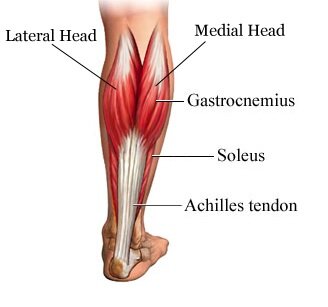Calf Muscles
Anatomy
The calf muscles are composed of 2 main muscles, the gastrocnemius and the soleus. [1,2]
Both muscles are responsible for extending the ankle, but the gastrocnemius primarily acts when the knees are fully extended and the soleus acts when the knees are bent at 90°. [2] Both muscles are important contributors to jogging, sprinting, and jumping. [3]
Injuries
Calf strains are one of the most commons injuries in popular sports such as soccer or Australian Football. [3,4] In a recent study that examined calf injuries in the AFL, soleus strains were not only the most prevalent, but also required a longer recovery time compared to gastrocnemius strains. [3] These findings suggest that the soleus muscle needs to be sufficiently strengthened for injury prevention. Calf strains typically occur during eccentric contraction when running, jumping, or changing directions. [5] The severity of calf strains has been shown to depend on the location of the tear on the muscle, as well as the size of the tear. [4]
Exercises
The soleus is commonly thought to be neglected in exercise programs since most calf exercises are performed in positions where it is inactive. So be sure to target both the gastrocnemius and the soleus when strengthening your calf muscles. Here are some calf exercises and stretches for each muscle:
Gastrocnemius Exercises:
Calf Raises off of a step (Double or Single leg)
Tip toe Walks (forward/backward, side to side)
Plyometric Jumps with knees straight
Soleus Exercises:
Seated calf raises with weight placed on top of thighs
Knees bent calf raises (Double or Single leg)
Hip Bridge with Heel lift (Double or single leg)
Heel Lifts in a Lunge Position (Forward foot heel lift)
Stretches:
Knee to wall stretch (Gastrocnemius)
Bent Knee to Wall Stretch (Soleus)
If you have any questions regarding your calf muscles or think you may benefit from physiotherapy, please give us a call at (02) 8411 2050. At Thornleigh Performance Physiotherapy, we can give you an accurate diagnosis and treatment, to help you get back in action as soon as possible. We are conveniently located near Beecroft, Cherrybrook, Hornsby, Normanhurst, Pennant Hills, Waitara, Wahroonga, Westleigh, West Pennant Hills, and West Pymble.
References
Bryan Dixon J. Gastrocnemius vs. soleus strain: how to differentiate and deal with calf muscle injuries. Curr Rev Musculoskelet Med. 2009;2(2):74‐77.
Nsitem V. Diagnosis and rehabilitation of gastrocnemius muscle tear: a case report. J Can Chiropr Assoc. 2013;57(4):327‐333.
Green, B., Lin, M., Schache, A., McClelland, J., Semciw, A., Rotstein, A., Pizzari, T. (2020). Calf muscle strain injuries in elite Australian Football players: A descriptive epidemiological evaluation. Scandinavian Journal of Medicine & Science in Sports, 30(1), 174-184.
Pedret, C., Rodas, G., Balius, R., Capdevila, L., Bossy, M., Vernooij, R., & Alomar, X. (2015). Return to Play After Soleus Muscle Injuries. Orthopaedic Journal of Sports Medicine, 3(7), 2325967115595802.
Bright, J., Fields, K., & Draper, R. (2017). Ultrasound Diagnosis of Calf Injuries. Sports Health: A Multidisciplinary Approach, 9(4), 352-355.

